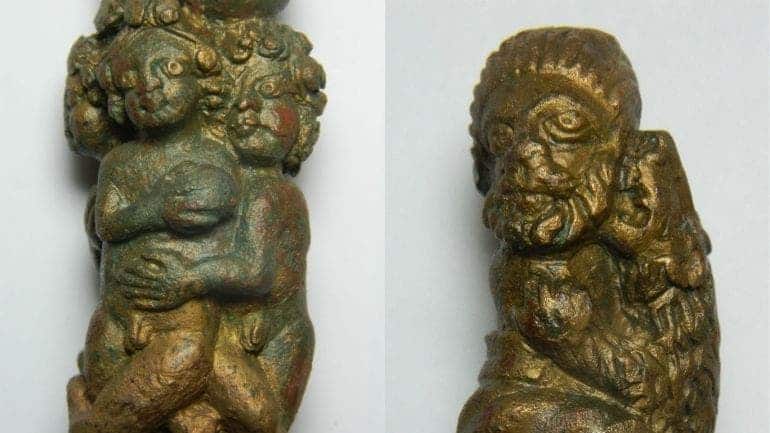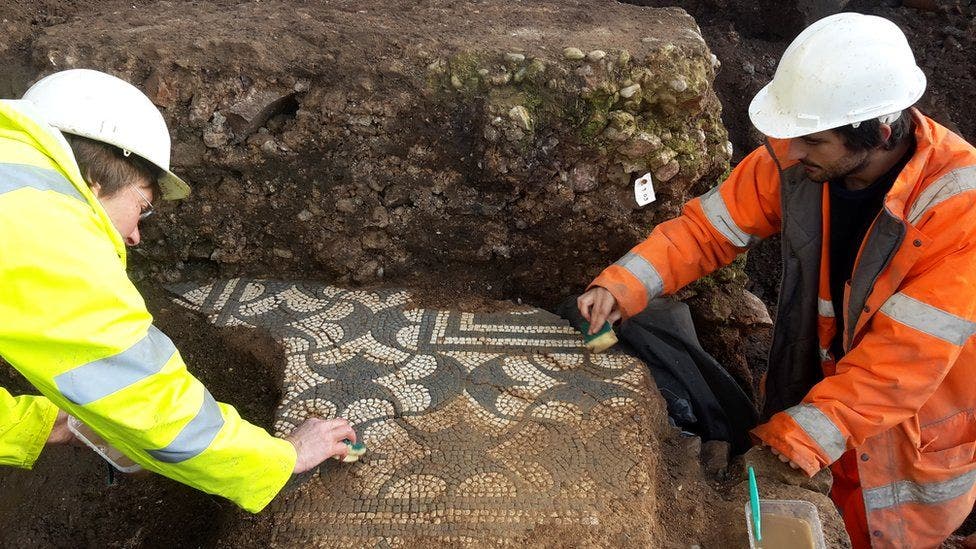
It was rather common during ancient Rome, especially in times of economic hardship, to have prisoners, slaves, criminals, and various enemies of the state executed by feeding them to hungry circus animals, including lions and tigers. This capital punishment, known as Damnatio ad bestias (“condemnation for beasts”), is thought to have been widespread across the Roman empire, but it was only recently that archaeologists have found the first evidence that lions may have been used in executions in Britain.
Archaeologists surveying a site in Leicester came across an elaborately decorated Roman bronze key handle depicting a man locked in pitch battle with a ferocious lion, under the eyes of four naked and fearful youths. According to researchers at King’s College in London, this artifact likely depicts the execution of a ‘barbarian’, the fate of all who dare oppose Rome.
This unique artifact was found buried under the floor of a late Roman townhouse excavated in 2016.
“When first found, it appeared as an indistinguishable bronze object, but after we carefully cleaned off the soil remarkably we revealed several small faces looking back at us, it was absolutely astounding, ” said Dr. Gavin Speed, who led the excavations at a site off Great Central Street in Leicester
“Nothing quite like this has been discovered anywhere in the Roman Empire before.

The figure portrayed on the bronze key handle displays features typically associated with ‘barbarians’ (basically anyone not Roman or Greek), including a mane-like hair, bushy beard, bulging eyes, and trousers below a naked torso. The lion is about to deliver the killing blow, being wrapped around the body of its victim with its open mouth menacing the side of the head. The four youth witnessing the scene are thought to symbolize the ‘children of the tribe’, their harrowing experience serving as a warning to those who would oppose Roman dominion.
“A cautious reading of the handle would see it as a similarly generic representation of damnatio, albeit an unusually vivid one. However, recent osteological studies give grounds for suggesting that spectacles of this kind involving lethal violence were familiar to British audiences. In particular, the analyses of fragmentary human skeletal material from the London Wall and of skeletons from graves in the cemetery south-west of Roman York have linked them plausibly to arena violence. In both cases the remains are those of adult males of geographically diverse origins and show signs of frequent violent trauma, both over their lifetimes and as the cause of their deaths. One York individual’s pelvis bears possible puncture wounds from an as yet unidentified animal, and so takes us a little closer to a likely spectacle context in which humans met their deaths through violent contact with animals. Taking this evidence into account, and noting the evidence described above for destruction of captives in the provinces as well as in the metropolis, it is not impossible that the handle’s creation was inspired directly by a spectacle located in Britain, even perhaps in the adjacent theatre,” the researchers wrote.

The artifact itself was probably forged a century or more after Britain was conquered by Rome by Emperor Claudius in 43 AD. Judging by its intricate ornaments, this fancy key probably served less of a functional role. Instead, it was probably used like a charm item that granted security and protection to the household.
Besides the exquisite key handle, archaeologists working at the Leicester Roman site also found a wonderfully preserved mosaic floor, roads, and an ancient theater.
The key handle will probably be displayed to the public at the Jewry Wall Museum in Leicester, following the completion of major refurbishment work expected to be completed by 2023.
The findings were reported in the journal Britannia.






